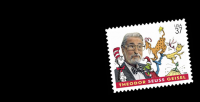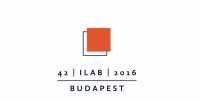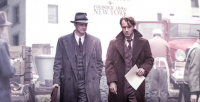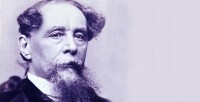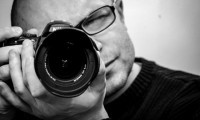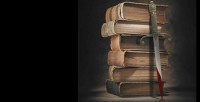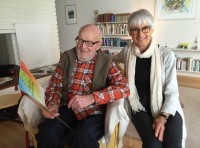If someone says “Children's Books” to you, what is the first thing that comes to your mind? Picture books? Perhaps here is the better question… what author first comes to mind? I would venture to bet that at least 90% of you come up with the same name. However, did you know that the name you come up with is not his true name? (Probably most of you do, since you are members of the book world or bibliophiles and would know something like that… but humor me!) Theodor Seuss Geisel was born on March 2nd, 1904 to a German family in Springfield, Massachusetts. His father ran a family-owned brewery in Massachusetts (well, until the Prohibition did away with that). Geisel went to school in Massachusetts until he went to Dartmouth College in New Hampshire, graduating in 1925. During his time at Dartmouth, Geisel first showed skill and interest in humorous literature as rose to the role of editor-in-chief of the literary magazine the Dartmouth Jack-O-Lantern before graduating. Unfortunately, one college incident threatened to end his early literary career – when Geisel was caught drinking gin (the Prohibition was in effect) in his dorm room with some of his friends. In punishment for this crime, Geisel was forced to resign from his position at the magazine. In order to continue publishing his work at the Jack-O-Lantern, Geisel began writing under the pen name “Seuss”, his middle name. The beginning of Dr. Seuss was underway. Once graduating from Dartmouth, Geisel began his... [more Dr. Seuss: Rare Books & Ephemera]
ABAA-member Jennifer Johnson of The Book Shop in Covina, CA, has been awarded a Young Antiquarian Scholarship by the Hungarian Antiquarian Booksellers' Association to attend the International League of Antiquarian Booksellers' (ILAB) Congress in Budapest in September, 2016. ABAA-President Mary Gilliam writes of Johnson that “Ever since joining the Association, Jen has been very supportive of, as well as involved in, Association activities, e.g, serving on the Southern California Book Fair committee, and organizing the now ever-popular Poker Tournament, which has raised ~ $15,000 for the ABAA Woodburn Educational Fund." "Jen represents the next generation of booksellers, and epitomizes the type of bookseller to whom we wish to entrust our beloved trade; e.g., along with , they broke new ground in terms of identifying and compiling archives, one example of which is their Heavy Metal catalogue of 2014, the first of its kind, which sold en masse to an institution who also recognized their vision of documenting a modern day musical movement." Johnson said she is “honored and proud to be selected and can't wait to share my experiences with everyone." A native of Nebraska and a graduate of Pepperdine University, Johnson is a former newspaper reporter and public relations executive. She became an associate member of the ABAA in 2010 and a full member in 2016. The ILAB Congress takes place in Budapest, Hungary from September 21 to 23, 2016. [more Johnson Awarded Young Antiquarian Scholarship]
Maxwell Perkins was the most famous editor of the golden age of American letters, working with Ernest Hemingway, Thomas Wolfe, Marjorie Kinnan Rawlings, F. Scott Fitzgerald, and many others. Rather than attempt to compress his mammoth career into two hours, the new film Genius, starring Colin Firth and Jude Law, focuses on Perkins relationship with Thomas Wolfe, perhaps his most gifted author, but also his greatest challenge. ABAA members offer many interesting items connected to Maxwell Perkins and his stable of famous authors, from glamorous first editions and rare books, to unexpected ephemera like mundane letters between the editor and various literary executors. Carolina Folk Plays: Second Series. Edited with an Introduction on Making a Folk Theatre by Frederick H. Koch New York: Henry Holt and Company, 1924. First edition. Thomas Wolfe's first appearance in a book, following the separate publication of his "Crisis in Industry.". 8 photographic illustrations including one which shows Wolfe portraying Buck Gavin, two woodcuts by J.J. Lankes and another by Mary De B. Graves. xxxiv, 173, pp. 1 vols. 8vo. Original buckram, lettered in green. Fine in pictorial cream dust jacket, with small loss on top of front panel, with price change on front cover from $1.75 to $2.00. In blue cloth box and chemise. Contains Thomas Clayton Wolfe's first play. Written for his dramatic writing course, the "Carolina Playmakers" taught by Frederick H. Koch. When it was produced in March 15 and 1... [more Max Perkins: Genius Editor]
Charles Dickens was only 58 years old when he passed away. He had long pushed himself too hard for the love of his work and his followers, and in the summer of 1870 (June 9th, to be exact) he succumbed to exhaustion and after experiencing a fatal stroke, was laid to rest. His work, however, has gone on to be remembered since, and the author has never been out of print. His final work, The Mystery of Edwin Drood, has long fascinated fans, as the murder mystery was unfinished at his death and Dickens never (formally) named the murderer. On this the 145th anniversary of the author's death, we look at his last years and his final work – a novel that he persisted on writing, even while suspecting his end was near. Dickens' health began to decline when he was involved in the Staplehurst rail accident on June 9th 1865 (five years to the day before his death, coincidentally). On his return from Paris with his young mistress Ellen Ternan and her mother, the train they were traveling on plunged off a cast iron bridge that was under repair. Luckily, the only 1st class carriage to remain on the track was that one in which Dickens was traveling. Until more aid arrived to tend to the victims, Dickens scrambled around the horrific scene offering brandy and a hat with water, looking after the dead, dying and wounded around him. The tragic incident cast a shadow on Dickens' life – the horror and absolute panic he experienced led to sleepless nights and night terrors for the rest of his sh... [more Charles Dickens’ Final Chapter]
These items are still missing as of 6/14/2019. The following books have gone missing from a locked display case at the Cortez Street Emporium, in Prescott, Arizona, sometime between May 9th and May 25th: MacDonald, Ross (Kenneth Millar). The Blue Hammer (Author's Proof Copy, Annotated). New York; Alfred A. Knopf, 1976. First edition, octavo; an uncorrected proof copy in yellow printed wrappers. The author's own copy with more than 60 holograph corrections to the text, in pencil. Page references for all of these corrections are given in pencil on the front wrapper, by MacDonald. Laid in are two pages of typed corrections to the text, signed "B" with quirky little remarks to MacDonald, prepared by fellow mystery writer William Campbell Gault, who is the dedicatee of the book and here a proof reader. A fine copy housed in a custom leather-backed clamshell box. Faulkner, William. Idyll in the Desert. New York; Random House, 1931. First edition, number 388 of 400 signed by the author; red marbled boards, with paper label on front board. Near fine, lacking the glassine dust jacket. Please contact the ABAA if offered. [more Missing from Prescott, Arizona]
The fourth installment of Kaitlin Manning's series on taking better pictures of rare books and ephemera. No matter what kind of camera you use, there are a few basic practices you can apply before you start shooting to improve the look and quality of your images (and to avoid fixing time consuming mistakes later on). While it is true that editing programs like Lightroom, Photoshop, and Gimp can work wonders and correct a myriad of errors, you will want to spend as little time as possible in these programs, especially if you are dealing with hundreds of photos at a time. Starting with good quality images from the beginning will eliminate the need for major edits -- and this begins before you even click the shutter. Make sure you have enough light. I've covered the basics of putting together a home studio in a previous post, but let me reiterate the need for good, diffuse light now. If your photos continuously look dull or underexposed, consider adding more light to the scene, but always make sure that it is properly diffused (i.e. there needs to be something translucent between the light and the object). Bare bulbs look harsh, create shadows, increase glare, and can either wash out or obscure details. Invest in a tripod. This was also mentioned briefly in a previous post, but let me elaborate a bit here: if you don't have the steadiest of hands and/or you routinely shoot manually in low speeds (generally less than 1/60 of a second) a tripod is a must. Camera shake can make you... [more The Savvy Bookseller: Tips and tricks before you shoot]
Friday, May 20th will see the premiere of my new opera with composer Stella Sung, a “rare book” opera, if you will, called The Book Collector, in which two men vie for possession of an exceedingly rare book. Why a rare book opera, you may ask? In truth, the opera is driven by the forces that have defined opera since its earliest days: jealousy and love, vengeance and mercy, the clash of social classes, free will bound by fate, and tragic, sometimes deadly misunderstandings. The auction floor, the bookseller's shop, the private library, and the book itself really serve as settings and props for the larger human ambitions that animate the characters. The “rare book” aspect of the opera was Stella's. She's long been fascinated by my day job at Bauman Rare Books. In fact, the first time we met in person was at the Florida Antiquarian Book Fair, the Florida Antiquarian Booksellers' Association's show held in St. Petersburg's Historic Coliseum (my friend Dana Gioia, former chair of the National Endowment for the Arts, first introduced the two of us as collaborative partners, but our work up to that point was done long-distance). Before we began work on The Book Collector, I had already worked with Stella as a librettist but, as the Dayton Daily News explains, my background situated me ideally—as both librettist and rare book dealer, perhaps a unique combination—“to fashion a plausible scenario for this particular opera.” Having worked at Bauman Rare Books for nearly... [more An Opera for Antiquarians]
Longtime Bay-area member Barney Rosenthal recently turned 94! (He was still buying and selling books up until very recently, too.) Here's the lovely card signed by his colleagues. Happy birthday, Barney! [more Barney Rosenthal Turns 94]
Michael Hackenberg, on behalf of the the Northern California Chapter of the Antiquarian Booksellers' Association of America is pleased to announce that the winner of the 2016 Kane Memorial Scholarship is Kyna Mallery of Back of Beyond Books in Moab, Utah. She will be using the $1500 scholarship to attend this summer's Colorado Antiquarian Book Seminar. Our congratulations to her! [more Kyna Mallery winner of 2016 Kane Memorial Scholarship]
This item is still missing as of 6/13/2019. Missing in transit to Spain: WERNER, Abraham Gottlob. Von den Ausserlichen Kennzeichen der Fossilien. Leipzig: Siegfried Lebrecht, 1774. 8vo. With 8 folding plates. Contemporary half-calf over boards. Please contact Howard Rootenberg at blroot@rootenbergbooks.com if offered. [more Missing in transit to Spain: Von den Ausserlichen Kennzeichen der Fossilie]


